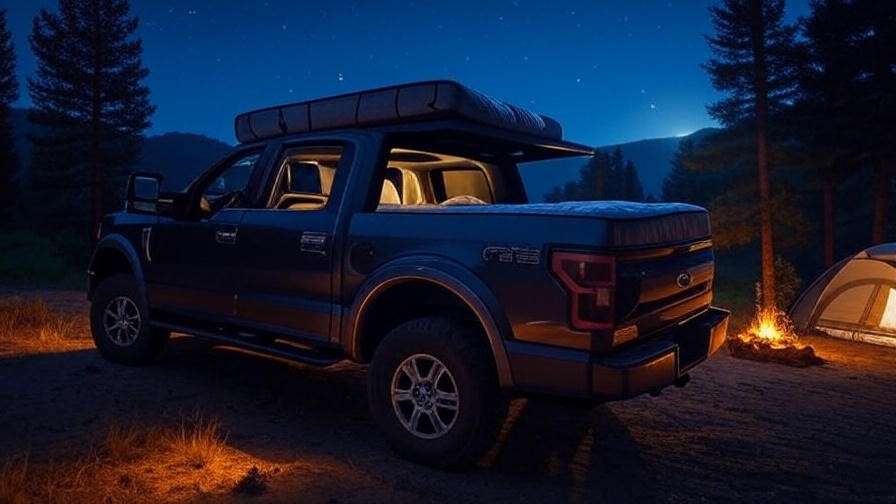Picture this: you’re cruising down a scenic highway in your Ford F150, the open road stretching endlessly before you. After a day of adventure, you pull into a quiet campsite, crawl into a cozy, custom-built Ford F150 sleeper, and drift off to a restful night’s sleep under the stars. No hotel bookings, no cramped tents—just your truck transformed into a mobile sleep sanctuary. For truck owners who crave freedom, adventure, and holistic well-being, a Ford F150 sleeper setup offers the perfect blend of practicality and comfort. Whether you’re an overlander, a long-haul worker, or a weekend warrior, this guide will show you how to create a sleeper that prioritizes sleep quality, mental clarity, and relaxation on the go. Backed by expert insights and real-world examples, we’ll walk you through every step to turn your F150 into a haven for rest and rejuvenation.
Why a Ford F150 Sleeper? Benefits for Well-Being and Adventure
The Appeal of Sleeping in Your Truck
Sleeping in your Ford F150 isn’t just about convenience—it’s a lifestyle choice that supports holistic well-being. A well-designed sleeper setup allows you to escape the stress of daily life, connect with nature, and enjoy the freedom of the open road. Quality sleep is the cornerstone of mental clarity, emotional balance, and physical health. By creating a comfortable sleep environment in your truck, you can reduce stress, improve focus, and wake up refreshed for your next adventure. Whether you’re camping in the mountains or parked at a rest stop during a cross-country drive, a Ford F150 sleeper ensures you’re well-rested and ready to tackle the day.
Why the Ford F150 is Perfect for a Sleeper Conversion
The Ford F150 is a top choice for sleeper conversions due to its spacious truck bed, robust build, and extensive aftermarket support. Available in multiple bed sizes (5.5ft, 6.5ft, and 8ft), the F150 offers flexibility to suit various needs, from solo travelers to couples. Its high payload capacity—ranging from 1,410 to 3,270 pounds depending on the model—means you can add a sleeping platform, mattress, and storage without compromising performance. Compared to competitors like the Chevy Silverado or Ram 1500, the F150’s widespread popularity ensures a wealth of accessories and community knowledge, making customization easier and more affordable.
Real-Life Use Cases
Take John, a 34-year-old overlander from Colorado, who transformed his 2020 Ford F150 into a sleeper for a six-month cross-country journey. By building a simple platform with a memory foam mattress, he created a cozy setup that allowed him to sleep comfortably in national parks and remote BLM lands. “It’s like having a hotel room wherever I go,” he says. “I wake up refreshed, and my truck is still ready for off-road trails.” Similarly, construction workers and festival-goers have embraced F150 sleepers for their practicality, proving that this setup is versatile enough for various lifestyles.
Planning Your Ford F150 Sleeper Setup
Assessing Your Needs
Before diving into your Ford F150 sleeper project, consider how you’ll use it. Are you a solo traveler needing a minimalist setup, or do you travel with a partner, requiring extra space? Will you use the truck bed for gear storage during the day? Aligning your setup with holistic well-being means prioritizing comfort and functionality. For example, if meditation is part of your routine, ensure there’s space for a small cushion or yoga mat. A clear plan tailored to your lifestyle ensures your sleeper meets your needs without unnecessary complexity.
Budget Considerations
A Ford F150 sleeper can be as affordable or luxurious as you want. A basic DIY setup with plywood, foam insulation, and a budget air mattress can cost as little as $200–$500. For a premium build with a camper shell, custom mattress, and high-end storage, expect to spend $1,500–$3,000. To keep costs low, source materials from local hardware stores or repurpose items like old drawers for storage. Investing in quality materials, such as a durable tonneau cover, can save money in the long run by protecting your setup from the elements.
Space and Size Constraints
The Ford F150’s bed size dictates your sleeper’s design. The 5.5ft bed is compact but ideal for solo travelers, while the 6.5ft and 8ft beds offer more room for couples or extra gear. Measure your bed carefully—width is typically 50–55 inches at the wheel wells, so plan your platform accordingly. For smaller beds, consider foldable platforms or modular storage to maximize space. Even in a compact setup, you can create a comfortable sleep environment by choosing the right mattress and organizing gear efficiently.
Essential Components of a Ford F150 Sleeper
Sleeping Platform and Mattress
The heart of your Ford F150 sleeper is the sleeping platform. A sturdy platform made from plywood or aluminum ensures stability and supports your mattress. For a lightweight option, use ¾-inch plywood reinforced with 2x4s. For the mattress, memory foam (4–6 inches thick) provides excellent comfort and conforms to the truck bed’s contours. Alternatively, tri-fold air mattresses are affordable and easy to store. Choose hypoallergenic materials to support respiratory health, especially if you’ll be sleeping in humid environments. A well-fitted mattress enhances sleep quality, reducing back pain and promoting relaxation.
Insulation and Weatherproofing
Temperature regulation is critical for restful sleep. Insulate your truck bed with foam board or Reflectix to maintain a comfortable temperature year-round. A tonneau cover or camper shell protects against rain, snow, and wind, while sealing gaps with weatherstripping prevents drafts. For extreme climates, consider a portable heater or cooling fan (ensure proper ventilation to avoid safety risks). A well-insulated setup not only improves sleep but also creates a calming environment conducive to relaxation and mindfulness.
Ventilation and Airflow
Proper ventilation prevents mold, reduces humidity, and ensures fresh air for better sleep quality. Install a roof vent or sliding windows in your camper shell to promote airflow. Portable battery-powered fans, like those from Ryobi or Milwaukee, are excellent for maintaining circulation in enclosed setups. If you’re using a tonneau cover without windows, crack the tailgate slightly (with a secure lock) to allow air exchange. Good ventilation supports respiratory health and prevents stuffiness, enhancing your overall well-being.
Storage Solutions
An organized sleeper reduces stress and keeps your truck functional. Build under-bed drawers using plywood or purchase pre-made plastic bins for easy access to gear. Overhead racks or netting can hold lightweight items like blankets or clothing. For a minimalist setup, use collapsible storage bags to save space during the day. A clutter-free environment promotes mental clarity, making your F150 sleeper a true sanctuary for rest and relaxation.
Step-by-Step Guide to Building Your Ford F150 Sleeper
Step 1: Measuring and Designing the Layout
Start by measuring your truck bed’s dimensions, including length, width, and height (with or without a camper shell). Sketch a layout on graph paper or use free design software like SketchUp to visualize your platform and storage. Plan for mattress placement, storage compartments, and headroom if you’re adding a camper shell. Tools needed: measuring tape, pencil, and a level to ensure a flat platform. A precise design prevents costly mistakes and ensures a comfortable, functional sleeper.
Step 2: Building the Sleeping Platform
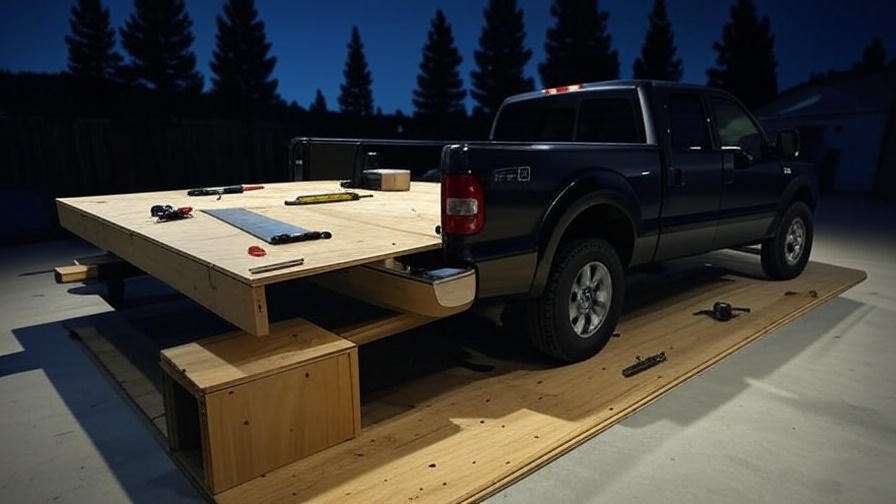
Materials: ¾-inch plywood, 2x4s, screws, wood glue, sandpaper.
Tools: Circular saw, drill, measuring tape, carpenter’s square.
- Cut plywood to fit your bed’s dimensions, accounting for wheel wells.
- Build a frame with 2x4s to support the plywood, securing with screws and glue.
- Sand edges for a smooth finish and safety.
- Secure the platform to the bed using tie-down anchors to prevent shifting.
Safety Tip: Double-check all measurements and ensure the platform is level to avoid discomfort during sleep.
Step 3: Adding Comfort Features
Install your mattress, ensuring it fits snugly on the platform. Add bedding like moisture-wicking sheets and a lightweight comforter for year-round comfort. For a calming aesthetic, use neutral colors like beige or gray to create a serene environment. Install battery-powered LED puck lights for soft, adjustable lighting—perfect for reading or meditation. A small storage caddy for essentials (e.g., phone, water bottle) keeps your space tidy and promotes relaxation.
Step 4: Installing Insulation and Ventilation
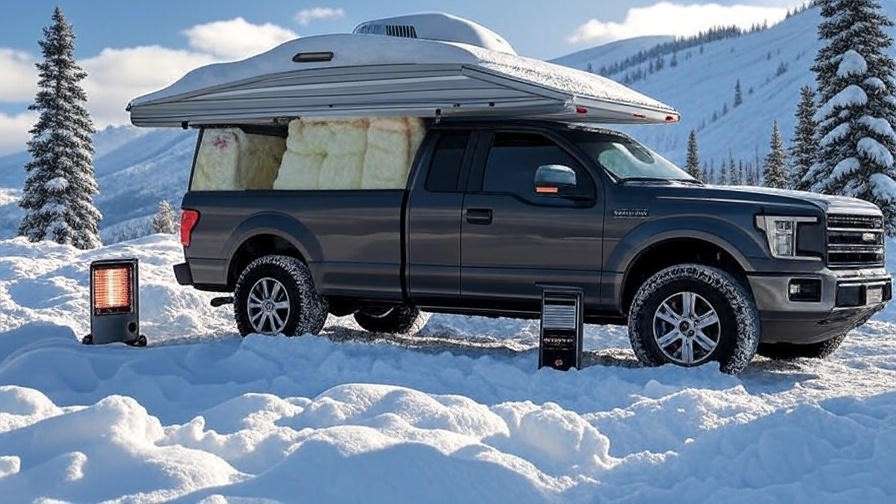
Apply foam board or Reflectix to the truck bed walls and floor, securing with adhesive or Velcro strips. For camper shells, insulate the ceiling to prevent heat loss. Install a roof vent (e.g., MaxxAir Mini) following manufacturer instructions, ensuring a watertight seal. Add a portable fan for additional airflow. For winter camping, a battery-powered ceramic heater (like Mr. Heater’s Buddy series) can keep you warm, but always use a carbon monoxide detector for safety.
Step 5: Final Touches and Testing
Before hitting the road, test your setup. Spend a night in your driveway or a local campsite to assess comfort, temperature, and functionality. Check for creaks, uneven surfaces, or ventilation issues. Create a checklist: Is the mattress comfortable? Is the platform secure? Does the insulation keep you warm? Adjust as needed, such as adding extra padding or sealing gaps. A trial run ensures your Ford F150 sleeper is ready for any adventure.
Enhancing Sleep Quality in Your Ford F150 Sleeper
Creating a Calming Sleep Environment
A Ford F150 sleeper isn’t just a place to rest—it’s an opportunity to craft a serene environment that promotes holistic well-being. Incorporate elements like aromatherapy by using a portable essential oil diffuser with calming scents like lavender or chamomile, known to reduce stress and improve sleep quality. Soundproofing can enhance tranquility; add foam panels or heavy-duty curtains to dampen external noise, creating a peaceful cocoon. Blackout curtains or removable window covers ensure darkness, supporting your body’s natural circadian rhythm. These small touches transform your truck into a mobile sanctuary, fostering relaxation and mental clarity.
Sleep Accessories for Comfort
To elevate your Ford F150 sleeper experience, invest in high-quality accessories. A portable white noise machine, like the LectroFan Micro2, masks disruptive sounds, such as passing traffic or wildlife, ensuring uninterrupted sleep. An ergonomic travel pillow, such as the Tempur-Pedic Neck Pillow, supports proper spinal alignment, reducing neck and back pain. For light sleepers, a silk eye mask blocks out residual light, promoting deeper rest. These products, chosen for their portability and effectiveness, enhance comfort without cluttering your setup. Always opt for durable, travel-friendly options designed for compact spaces.
Meditation and Relaxation Techniques
Your Ford F150 sleeper can double as a space for mindfulness practices, aligning with holistic well-being. Try a 5-minute guided breathing exercise before bed: Inhale for 4 seconds, hold for 4, exhale for 6, and repeat for 5 cycles. This technique, rooted in mindfulness research, calms the nervous system and prepares you for restful sleep. Alternatively, use a meditation app like Calm or Headspace, which offer truck-friendly sessions for relaxation. Keep a small yoga mat or cushion in your storage for quick stretching sessions, enhancing physical comfort and mental peace on the road.
Safety and Legal Considerations
Safe Parking for Overnight Stays
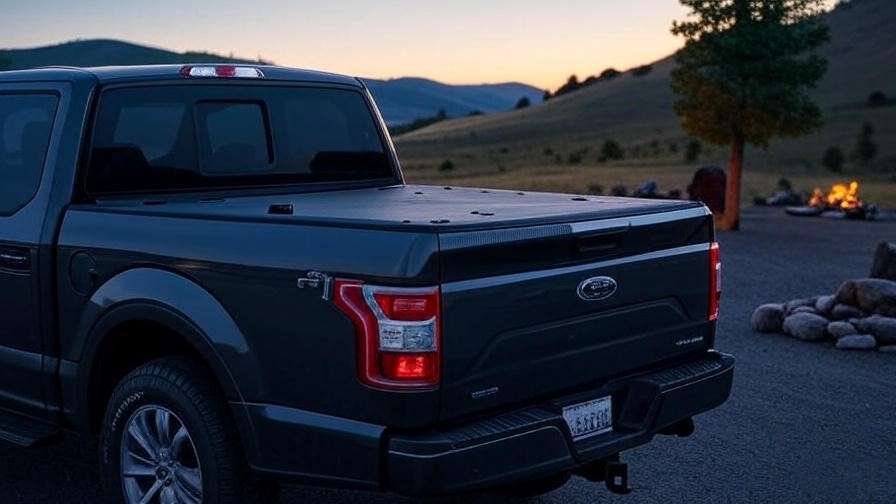
Choosing the right spot to park your Ford F150 sleeper is crucial for safety and peace of mind. Opt for designated areas like campgrounds, RV parks, or BLM (Bureau of Land Management) lands, which are often free or low-cost. Rest stops are a convenient option for long-haul drivers but check local regulations, as some prohibit overnight parking. Equip your truck with a carbon monoxide detector, especially if using a heater, and invest in a robust locking system for your camper shell or tonneau cover. Always park in well-lit, populated areas when possible to deter theft or vandalism.
Legal Regulations for Truck Camping
Laws about sleeping in vehicles vary by state and municipality, so research your destination in advance. For example, California permits overnight parking in some rest areas for up to 8 hours, while cities like Los Angeles may have stricter ordinances against vehicle dwelling. Use resources like the iOverlander app or FreeCampsites.net to find legal, truck-friendly spots. Carry a printed list of regulations for quick reference, and avoid parking in residential areas to respect local communities. Staying informed ensures your Ford F150 sleeper adventures remain hassle-free and compliant.
Maintaining Truck Performance
Adding a sleeper setup increases your F150’s weight, potentially affecting fuel efficiency and handling. Check your truck’s payload capacity (typically 1,410–3,270 pounds) and stay within limits to avoid strain on the suspension or engine. Regularly inspect tires, brakes, and shocks, as added weight can accelerate wear. A tonneau cover or camper shell improves aerodynamics, offsetting some fuel economy losses. Schedule routine maintenance, such as oil changes and alignment checks, to keep your truck road-ready. A well-maintained F150 ensures your sleeper setup enhances your adventures without compromising performance.
Real-World Inspiration: Ford F150 Sleeper Success Stories
Case Study 1: The Solo Overlander
Meet Sarah, a 29-year-old photographer who converted her 2018 Ford F150 into a minimalist sleeper for solo overlanding. Using a 6.5ft bed, she built a plywood platform with under-bed storage for camera gear and camping supplies. Her setup includes a 4-inch memory foam mattress, Reflectix insulation, and a MaxxAir vent for airflow. “I’ve slept in deserts, forests, and beachside lots,” Sarah shares. “My F150 sleeper gives me the freedom to chase sunrises without worrying about hotels.” Her story highlights how a simple, budget-friendly setup can support a nomadic lifestyle and mental well-being.
Case Study 2: The Family Camper
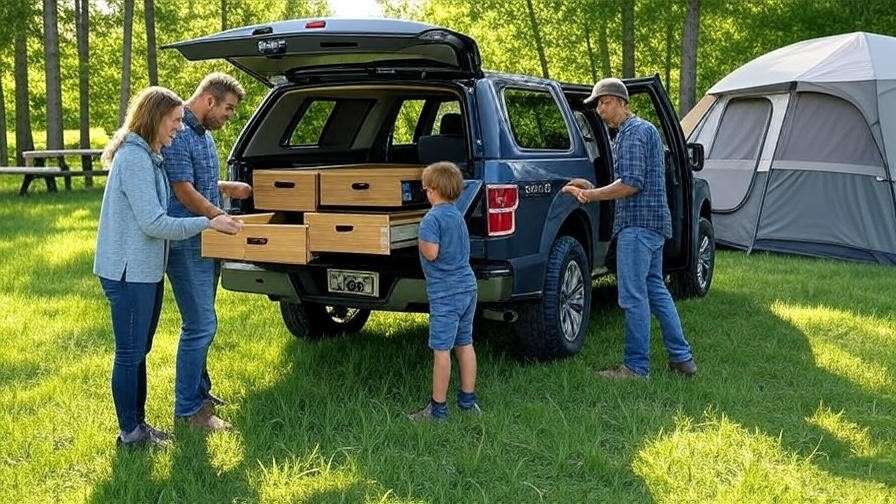
The Thompson family, based in Oregon, turned their 2022 Ford F150 with an 8ft bed into a family-friendly sleeper for weekend camping trips. They installed a camper shell with sliding windows, a 6-inch foam mattress, and custom drawers for clothes and cooking gear. “Our kids love the cozy vibe,” says Mark, the father. “We added fairy lights and soft blankets to make it feel like home.” The Thompsons’ setup proves that a Ford F150 sleeper can accommodate multiple people while fostering family bonding and relaxation in nature.
Community Insights
The truck camping community is a treasure trove of inspiration. On Reddit’s r/Overlanding and Ford F150 forums, users share tips like using modular storage crates for easy setup changes or adding solar-powered USB chargers for off-grid convenience. One X post from @TruckLife22 raved, “My F150 sleeper is my escape from the 9-to-5 grind. Nothing beats waking up to a mountain view!” These insights underscore the camaraderie and creativity in the truck camping world, encouraging newcomers to join the movement with confidence.
FAQs About Ford F150 Sleeper Setups
How much does it cost to build a Ford F150 sleeper?
Costs range from $200 for a basic DIY setup (plywood platform, air mattress) to $3,000 for a premium build with a camper shell and custom mattress. Budget options include secondhand materials or repurposed storage solutions.
Can I sleep in my F150 without a camper shell?
Yes, a tonneau cover or tarp can provide weather protection, but a camper shell offers better security and insulation. Ensure proper ventilation to avoid condensation and maintain air quality.
What’s the best mattress for a truck bed?
A 4–6-inch memory foam mattress cut to fit your bed size offers optimal comfort. Tri-fold air mattresses are a budget-friendly, portable alternative. Prioritize hypoallergenic materials for health.
How do I keep my F150 sleeper warm in winter?
Use foam board or Reflectix insulation, a portable ceramic heater (with a carbon monoxide detector), and thermal blankets. A camper shell with sealed windows prevents heat loss.
Are there any legal issues with sleeping in my truck?
Regulations vary by location. Research state and local laws using apps like iOverlander. Stick to designated campgrounds or rest areas to avoid fines or disturbances.
Conclusion
A Ford F150 sleeper is more than a practical solution—it’s a gateway to adventure, freedom, and holistic well-being. By transforming your truck into a cozy, functional sleep sanctuary, you can enjoy restful nights wherever the road takes you, from remote campsites to bustling rest stops. This guide has equipped you with the tools, steps, and inspiration to build a sleeper that aligns with your lifestyle, whether you’re a solo overlander or a family camper. Start planning your setup today, and experience the joy of waking up refreshed, surrounded by nature, in your own Ford F150 sleeper. For a head start, download our free Ford F150 Sleeper Checklist at [insert website link] to streamline your build and hit the road with confidence.

